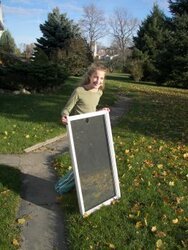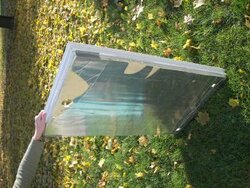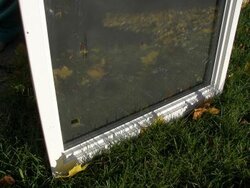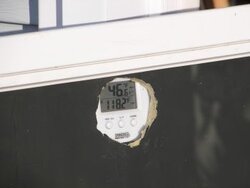I have 4 sheets of tempered glass approximately 36" x 72" (18sf each, 72sf total) that are laying around screaming "do something with me". I've kicked several ideas around and most recently thought about building a solar collector. Especially this time of year when we have fairly decent sun and day highs in the mid 60's but the house has a little chill due to still being in shade from all the trees. I'm hoping that 72sf of homebuilt collector might be able to keep a couple of rooms close to 70F and maybe give me a little head start on heating from the evening fire. I'm not planning on any storage and don't have room for a thermo siphon system. Just a couple of solar fans to move a little hot air when the sun shines.
Trouble is, searching the internet, I've found a ton of different designs with no real way to quantify what works best. Some have flat absorber plates, some are fluted or ribbed or rough, some have the absorber just under the glass with the air circulating behind, some have the absorber at the back with the air circulating above it, some put it in the middle and pump air down the front and back. I found a "rules of thumb" list, but it is going on 30 years old.
http://www.mobilehomerepair.com/solarrules.htm
I know there have been some discussion on hot water, but just curious if anyone has built a hot air collector and any input on the best design?
Trouble is, searching the internet, I've found a ton of different designs with no real way to quantify what works best. Some have flat absorber plates, some are fluted or ribbed or rough, some have the absorber just under the glass with the air circulating behind, some have the absorber at the back with the air circulating above it, some put it in the middle and pump air down the front and back. I found a "rules of thumb" list, but it is going on 30 years old.
http://www.mobilehomerepair.com/solarrules.htm
I know there have been some discussion on hot water, but just curious if anyone has built a hot air collector and any input on the best design?






 . we were suprised when something so simple actually worked !! we are about to take 3 more old patio doors and build 3 more to heat the garage , whose back wall happens to face south as well . it should keep it comfortable during the day . its about 150-200 sq ft. We did not build it using cans but lined ply-wood channels with heavy duty aluminum foil and painted it all black inside.
. we were suprised when something so simple actually worked !! we are about to take 3 more old patio doors and build 3 more to heat the garage , whose back wall happens to face south as well . it should keep it comfortable during the day . its about 150-200 sq ft. We did not build it using cans but lined ply-wood channels with heavy duty aluminum foil and painted it all black inside.